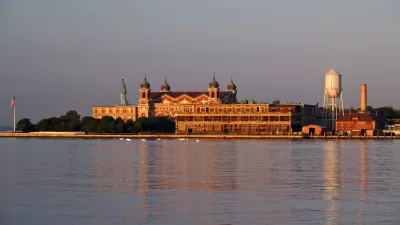With a surging homeless population, the city's cluster site program incentivizes slumlords and reduces the supply of affordable housing.

The cluster-site program, an emergency housing program for homeless New Yorkers, has been criticized as a dysfunctional shelter system, yet the 83-unit building at Clarkson Avenue, in the middle of a gentrifying Brooklyn neighborhood, represents "one of the most complex and intractable challenges confronting" New York City Mayor Bill DeBlasio, writes Vivan Yee for the New York Times.
The program, which pays for homeless people to live temporarily in privately owned buildings, began in 2000, when the homeless population was overwhelming city shelters. But with the city paying over $2,500 per month per family, the Clarkson Avenue building featured in Yee's story highlights the inefficiencies of a system wherein landlords stand to gain more from sheltering homeless people than by providing affordable housing for Section 8 voucher tenants and other low-income renters.
"Critics of the program, including advocates for homeless people, community leaders and elected officials, denounced it as a stopgap that papered over one problem only to worsen another, pushing low-income residents out of their homes and removing otherwise affordable apartments from circulation," reports Yee.
The program was supposed to be temporary, but the number of homeless people living in cluster-site buildings has steadily increased. The money designated to the program is also supposed to provide social services, including building security and employment assistance. However, conditions have deteriorated in these buildings. In one Ditmas Park building, "people loitered in the common areas, openly using drugs. Cockroaches clustered in the light fixture and refrigerator. Doors and windows were broken. The bathroom was moldy and pocked with rodent holes. There was no stove."
FULL STORY: Homeless Families Endure Roaches, Mice and Failed Promises

Maui's Vacation Rental Debate Turns Ugly
Verbal attacks, misinformation campaigns and fistfights plague a high-stakes debate to convert thousands of vacation rentals into long-term housing.

Planetizen Federal Action Tracker
A weekly monitor of how Trump’s orders and actions are impacting planners and planning in America.

In Urban Planning, AI Prompting Could be the New Design Thinking
Creativity has long been key to great urban design. What if we see AI as our new creative partner?

Milwaukee Launches Vision Zero Plan
Seven years after the city signed its Complete Streets Policy, the city is doubling down on its efforts to eliminate traffic deaths.

Portland Raises Parking Fees to Pay for Street Maintenance
The city is struggling to bridge a massive budget gap at the Bureau of Transportation, which largely depleted its reserves during the Civd-19 pandemic.

Spokane Mayor Introduces Housing Reforms Package
Mayor Lisa Brown’s proposals include deferring or waiving some development fees to encourage more affordable housing development.
Urban Design for Planners 1: Software Tools
This six-course series explores essential urban design concepts using open source software and equips planners with the tools they need to participate fully in the urban design process.
Planning for Universal Design
Learn the tools for implementing Universal Design in planning regulations.
Gallatin County Department of Planning & Community Development
Heyer Gruel & Associates PA
JM Goldson LLC
City of Camden Redevelopment Agency
City of Astoria
Transportation Research & Education Center (TREC) at Portland State University
Jefferson Parish Government
Camden Redevelopment Agency
City of Claremont





























